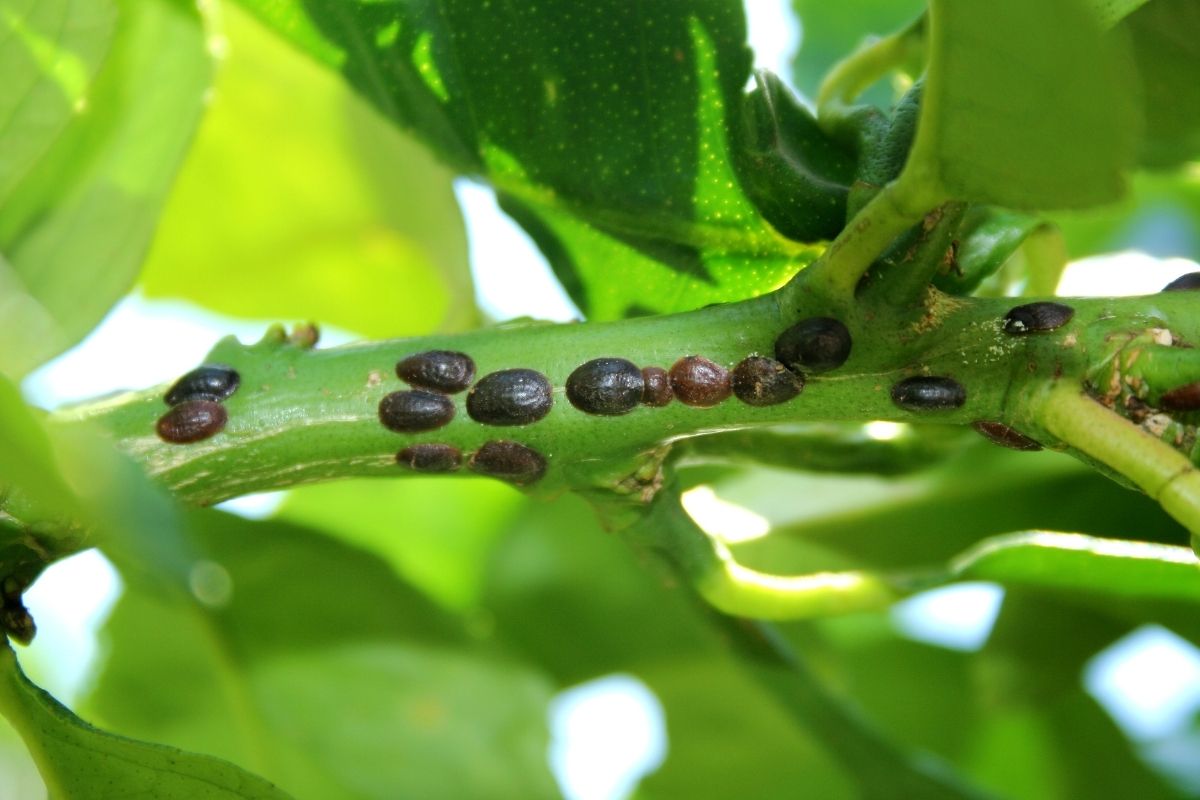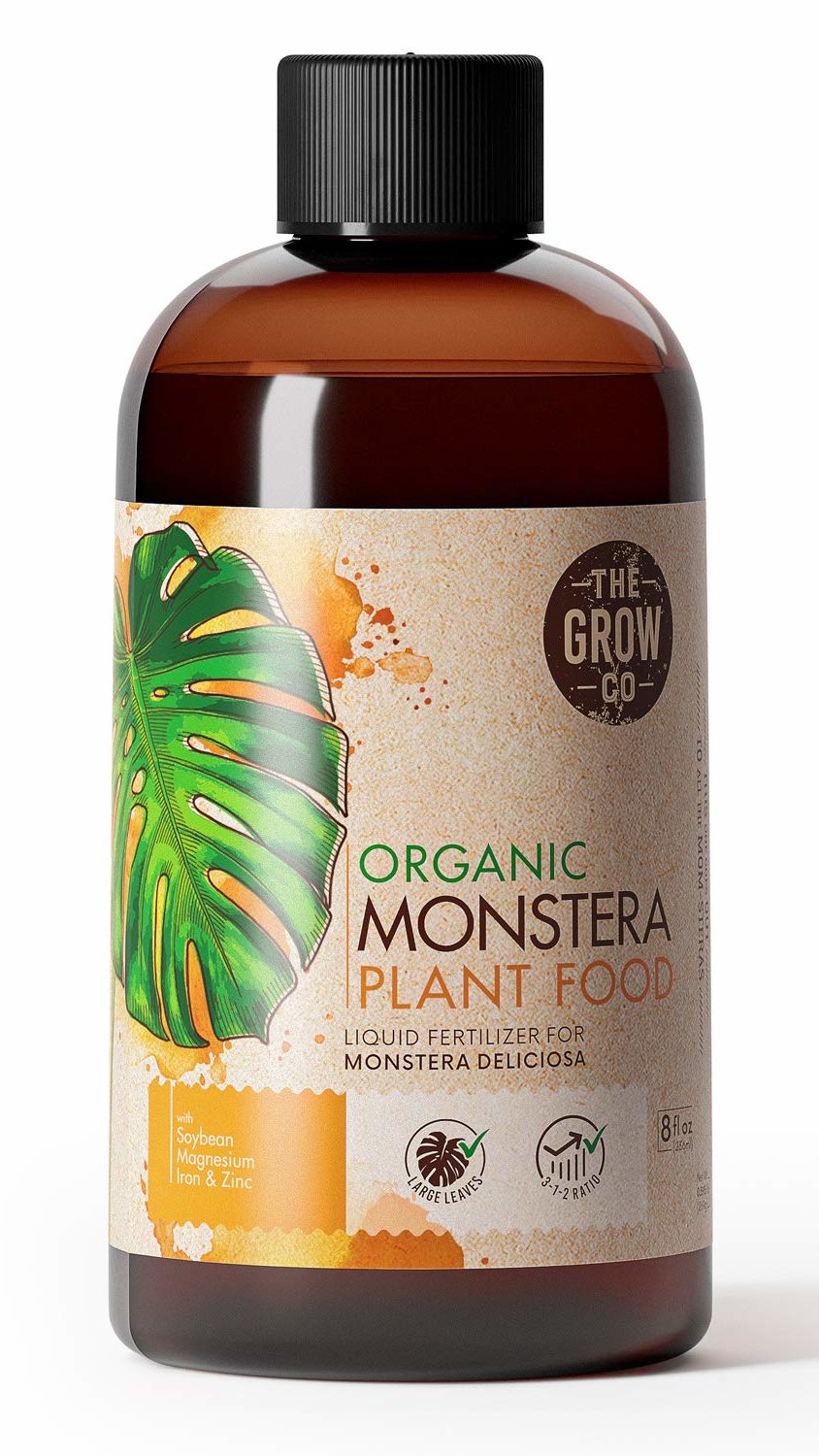If you’re putting up a fight with scale on monstera, you know the ups and downs🎢 Right when you think you’ve come out on top, the little buggers re-emerge with a new leaf shoot.
On the one hand: Yay, new leaf!
On the other: Ugh not more bugs!!
In this post, we’ll equip you with everything you need to know to rid your monstera of scale once and for all.
You can always take steps to prevent infestations, and we’ll cover that too 👍 But if your monstera happens to contract scale, there are a number of ways to eliminate it and restore your Monstera deliciosa to good health.
So…what is scale, really? Scale is a general term that actually refers to a pattern of infestation that can affect both indoor and outdoor plants, rather than a particular type of insect. Scale can, in fact, be caused by a variety of different insects (who knew?!), but they all affect the host plant in the same way. The hallmark scale patterns are clusters attached to the plant’s leaves and stem.
These clusters typically take one of two forms; hard scale and soft scale. Hard scale refers to the shell-like cover that protects the insects from predators. Soft scale forms a soft, waxy coating. It’s typically easier to wipe out a soft scale infestation, but the good news? Both are treatable.
What does a healthy Monstera look like?
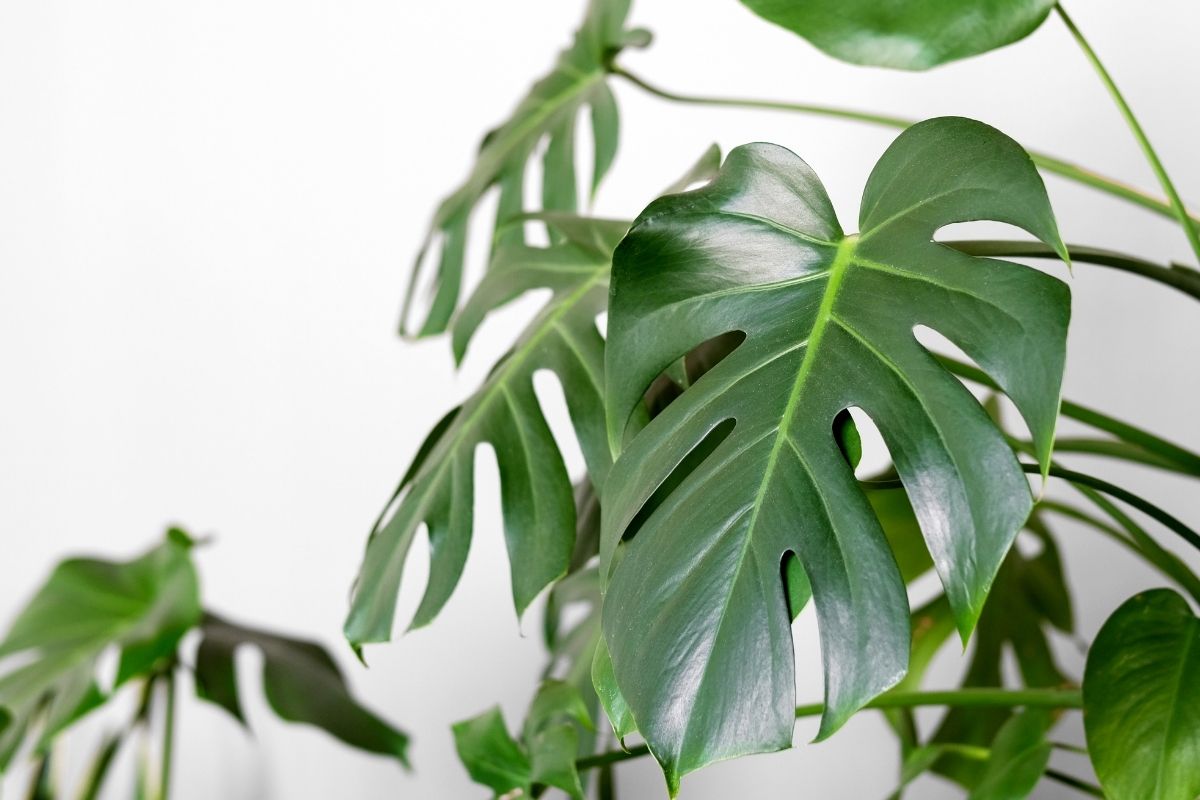
A healthy monstera that receives adequate water, sunlight and nutrients will have broad, waxy, green leaves and firm, upright stems. However, even healthy monstera plants need a bit of TLC to keep them free of insect infestations that can damage their leaves and stems. Watch for these signs of infestation on your healthy monstera plant:
- Yellowing or browning leaves
- Flies buzzing around the topsoil
- Fungus growing on the topsoil
- Weak, drooping stems
- Leaf burns and insect bite marks
- Any other obvious signs of damage to the plant.
You might also like: how often to water monstera plants
How do I know if my monstera has scale?
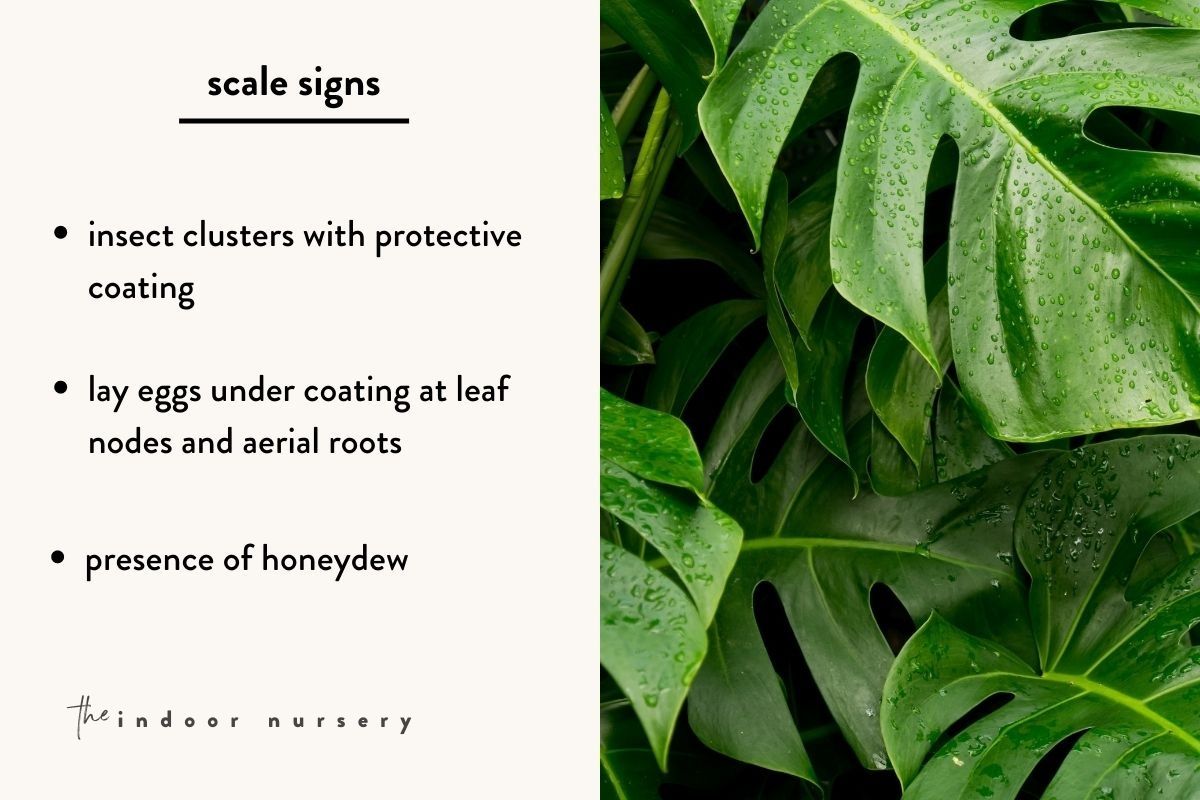
Scale sometimes sets in with other common plant problems, especially if you’ve overwatered your monstera. However, it’s still important to treat a scale infestation as soon as you notice it. It’s relatively easy to identify if your monstera has been infested by scale bugs.
Scale will take the form of insect clusters that are attached to the top or bottom of the leaves and along plant stems. The clusters form either a hard or soft coating to protect the insects, which will make the affected area brown or white in appearance.
The insects will lay eggs beneath the coating that is formed, which may be visible as well. Scale formations tend to burrow into crevices, so keep an especially close eye on the leaf nodes (where leaves and stems grow from other stems) and aerial roots of your monstera.
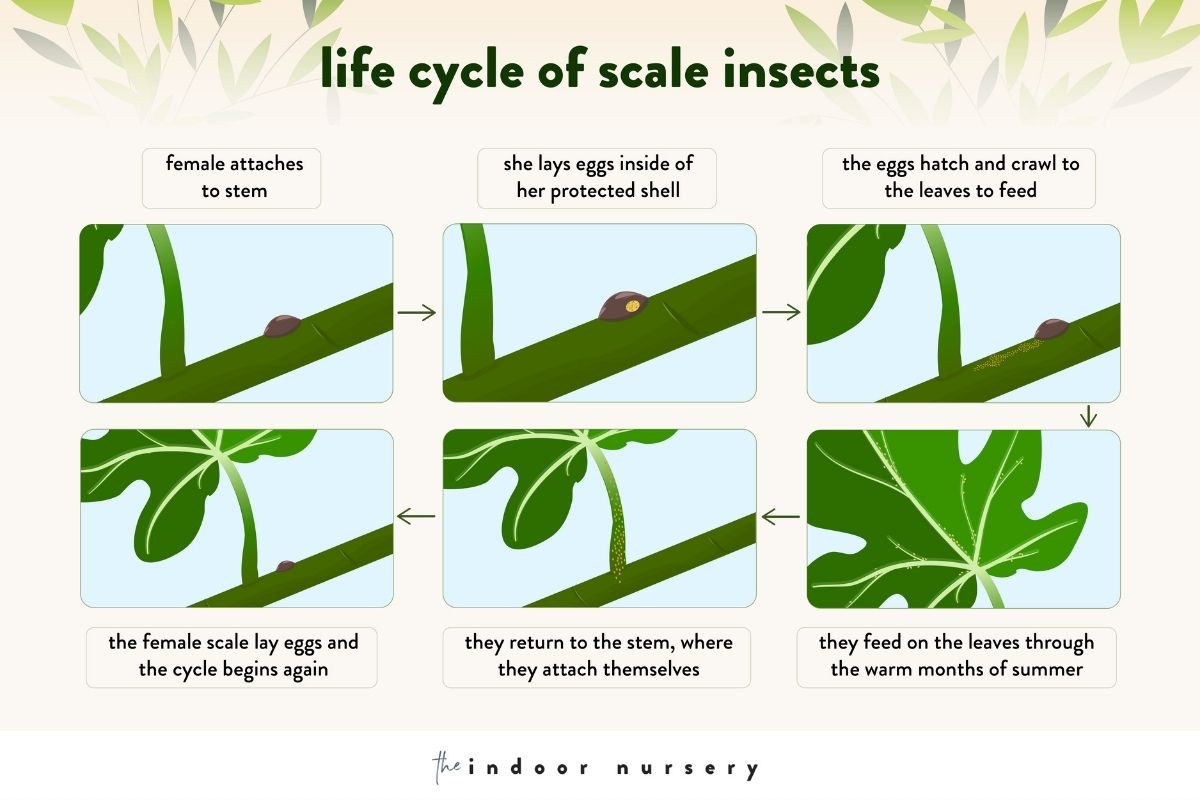
If you notice a sticky substance forming on the leaves, this can be a sign of scale, too. Why? Well, they suck moisture and sap from the host plant and secrete what’s called honeydew, a sweet-smelling and sticky substance, as a byproduct. The presence of honeydew invites fungal infestations as well, so make sure to look out for sooty mold forming on plant leaves and in the top layer of your monstera’s soil as well.
It’s a good idea to routinely check your monstera for scale infestation because the insects will eventually reproduce and can spread to adjacent leaves and nearby plants if you miss something.
Types of scale insects
There are literally thousands of different kinds of scale-forming insects. They vary in size and the type of scale they form on host plants. Depending on the species of insect that forms a scale infestation, they will form either a hard, armored coating which helps to protect the females and their eggs, or a weak, granular coating known as “soft scale,” which is far less protective for the insect population.
Armored scale is typically brown or black in color, while soft scales are usually white and powdery in appearance. The size of any given “scale” is generally between 1/16 to 3/8 inches.
The life cycle of scale insects does not vary much between species. Once attached to their feeding spot on the host plant, the females bury their legs in the plant tissue and remain immobile for the rest of their life. The scale coating protects them during reproduction.
All offspring, whether male or female, are born with legs so they can spread out and form new clusters on nearby leaves and plants. This is commonly referred to as the “crawler” stage, where the scale bugs freely roam, searching for a greener leaf where they can reproduce and feed in peace.
What does scale on Monstera look like?
If your monstera is infested with armored scale insects, you should see brown bumps on the top and/or underside of the foliage. Soft scale is typically white and powdery in appearance, and is more often found on the underside of leaves where the colonies are protected against predators.
Other warning signs that your monstera has become infested with scale bugs include mold or the presence of additional creepy crawlies, like ants. When honeydew decomposes, it invites fungal infections that feed on the natural sugars in the substance. Honeydew can also attract ants, which can actually worsen the scale infestation because they eat the natural predators of scale.
What causes scale and how to prevent it?
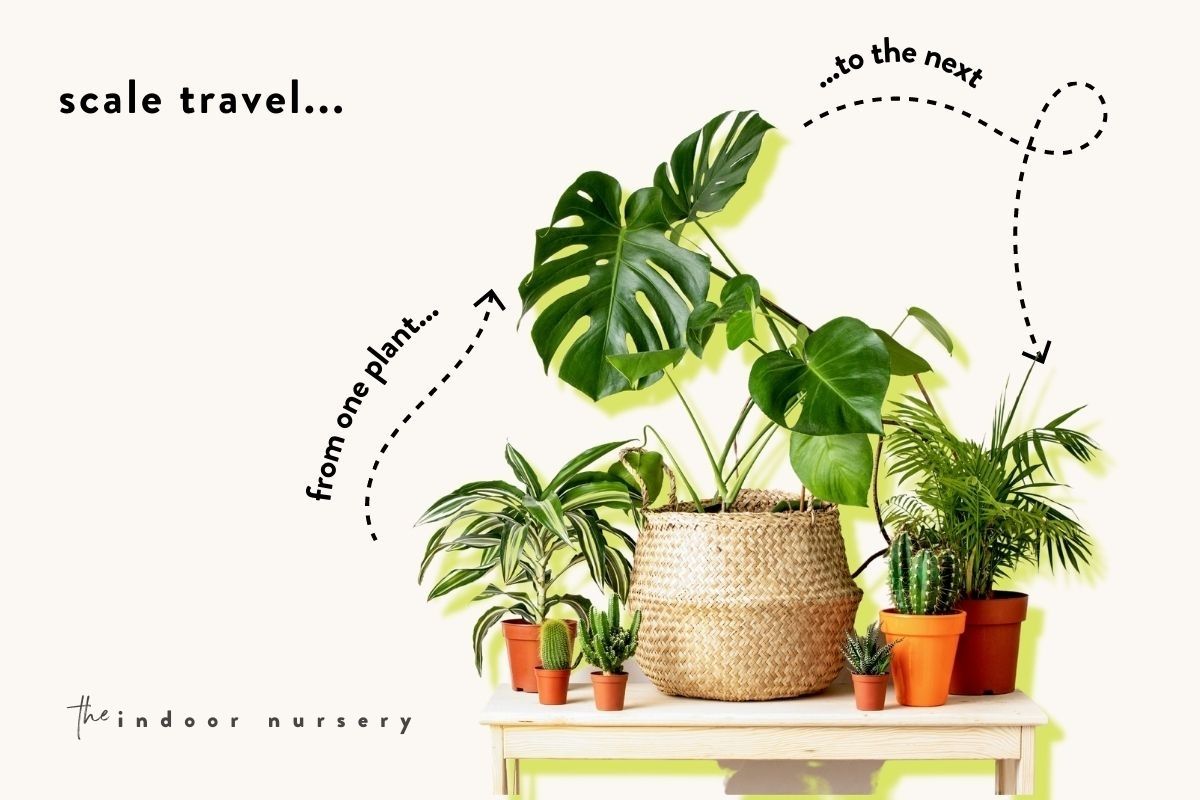
Where does this troublesome problem come from? Plants typically contract scale from nearby infestations on other plants. This makes it super important to quarantine any houseplants you have with scale while you treat them!
Regularly examining your plants and separating out any that show signs of infestation is probably the best way you can prevent scale from forming on your monstera. Keeping your monstera clean will also help deter scale 🧼 💦
No bathtub needed for this: Simply wipe down your Monstera’s leaves and stems with a wet cloth every 1-2 weeks (you can also do this with a diluted solution of neem oil, soap and water). This is a perfect time to look over your plant and check its soil for any signs of scale, too.
Relevant detour here: Is your monstera in the right soil? If not, your plant might be more susceptible to scale!! Check out our recommendation for the best soil for monstera plants if you’re not sure.
What damage does scale have on indoor plants?
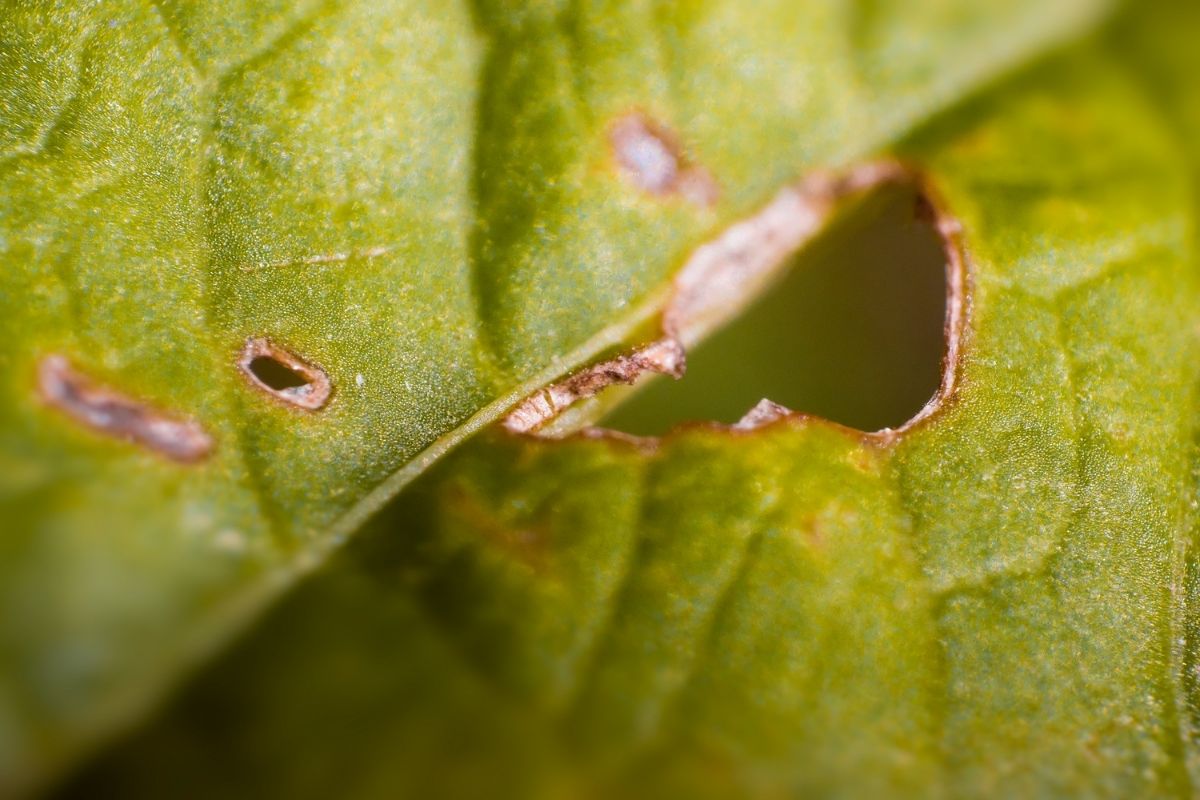
Thought that carnivores were the only things causing trouble on this plane? Think again!! Scale insects are herbivores and feed solely on the sap found in the tissue of host plants. If you find only a few insects on your plant and treat it quickly, your plant’s overall health shouldn’t be affected.
You might notice tissue damage (usually leaf discoloration, brown spots or holes) where the bugs burrowed in to feed, but no lasting damage. However, if you leave scale on indoor plants untreated, it will become weak from a lack of nutrients as the buggers suck its vital juices out and eventually die 💀.
How do you get rid of scale on Monstera?
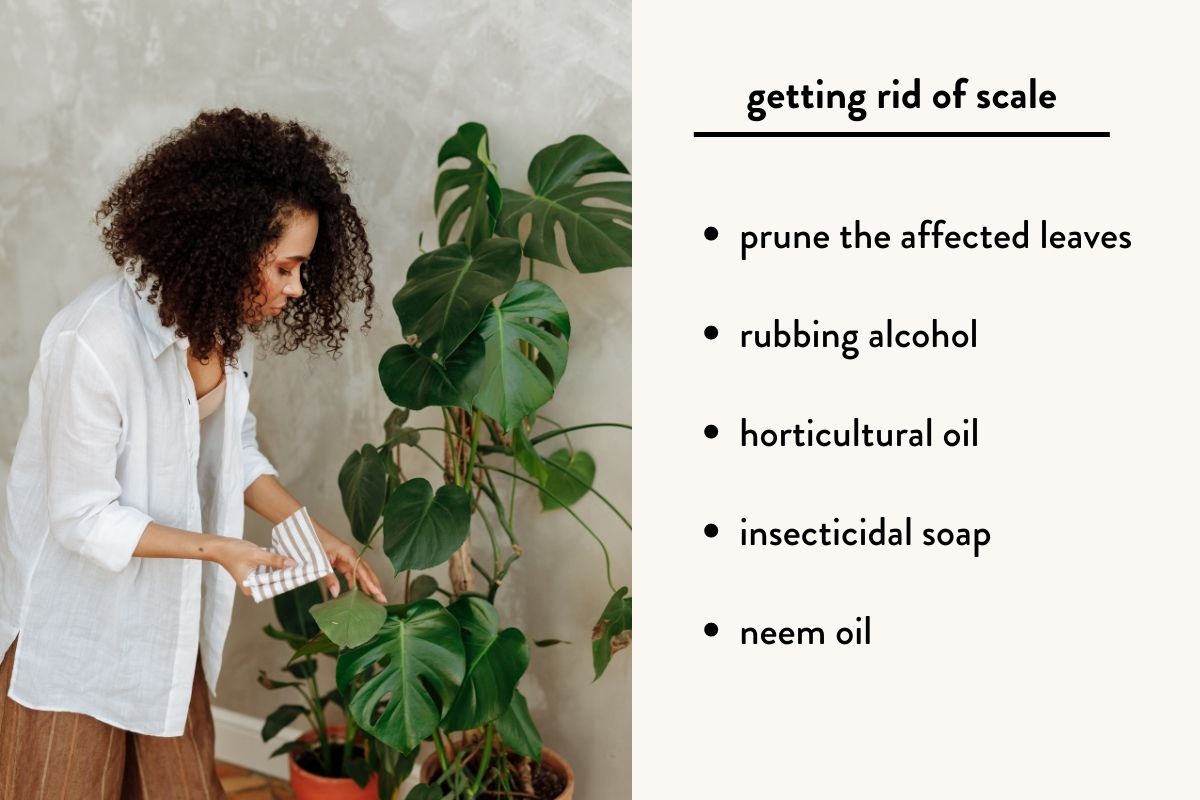
Sooo ok. You know the risks, and now it’s time for action! There are numerous ways to treat scale on monstera plants. Choosing the right method for your situation depends on the kind of scale you’re dealing with, how severe the infestation is, and what method works best with your existing plant care routine. Here’s a breakdown of your options:
Prune the affected leaves
The simplest option for treating scale is to prune the affected leaves. This is recommended if the infestation is new and only affects a small number of leaves or stems on the plant. Make sure to throw out the pruned plant material instead of composting in order to prevent further problems with scale.
Rubbing alcohol
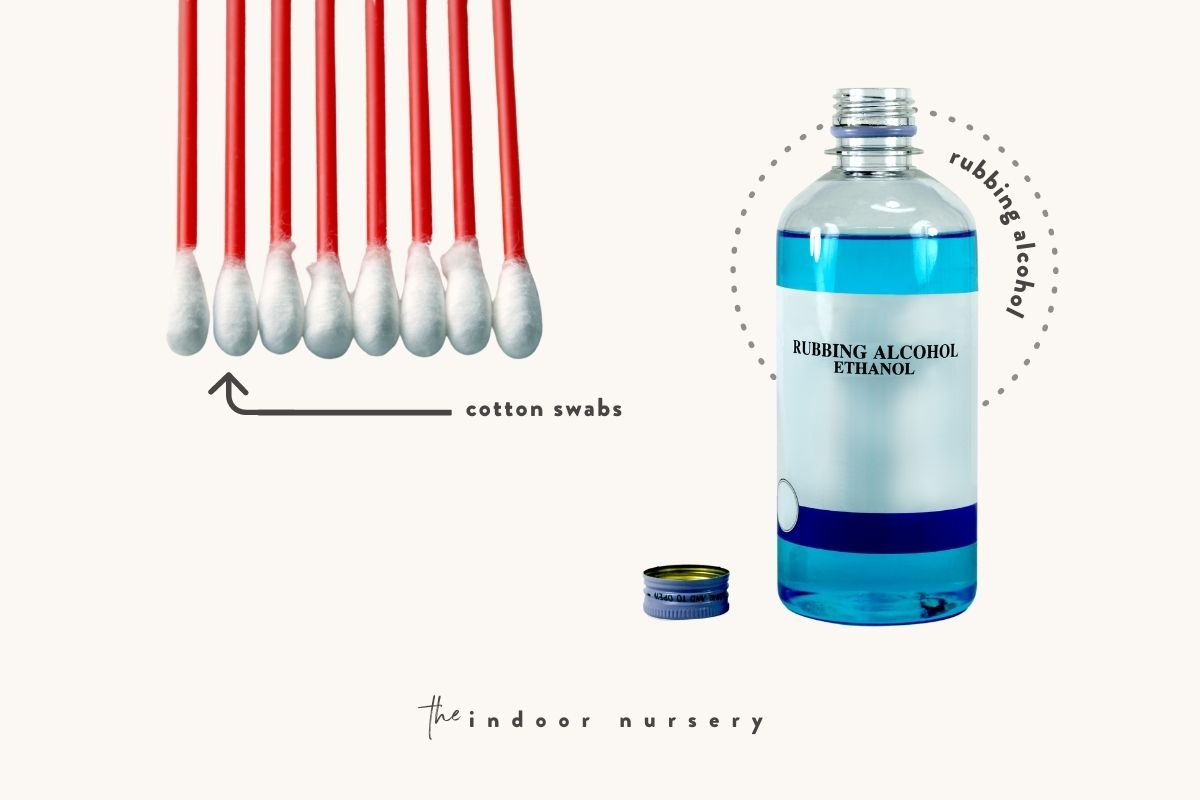
Rubbing alcohol is another effective way to kill a small population of scale insects. Simply dip a cotton swab in rubbing alcohol and apply directly to the scale. Repeat this process every 2 to 3 days until the entire infestation has been eradicated.
Horticultural oil
Horticultural oils are pesticides used to treat pest infestations and some diseases in plants. They are typically made from refined petroleum, but natural, plant-based oils are also available if you look for them. Regardless of the kind of horticultural oil you choose, they all effectively treat small to large populations of soft scale insects.
Horticultural oil treatment works best in the spring when new offspring start marching around and haven’t formed their protective layer. Fill a spray bottle with 2-5 oz per gallon of water and spray the affected plant along its leaves, stems and around its base.
Insecticidal soap
Another effective method to kill scale infestations is insecticidal soap. It’s best at killing larvae but not established and feeding adults. Insecticidal soaps can be purchased from the store or you can make your own homemade insecticide with soap and water.
This is what you’ll need for a homemade insecticidal soap:
- Fragrance-free soap
- Spray bottle
- Vegetable oil (optional)
How to apply it:
- Mix around 2.5 tablespoons of pure liquid soap in 1 gallon of water.
- Optionally, add 2.5 tablespoons of vegetable oil to the solution in order to increase its ‘staying power’ and shelf-life.
- Fill a spray bottle with the liquid.
- Cover your plant liberally with the solution, making direct contact with any visible pests.
To avoid potentially damaging an entire plant, be sure to test your solution on a small area of your monstera first and wait a day or two to see how your monstera reacts. If discoloration or burning occurs, discontinue use immediately and try a different method for removing the scale insects.
Neem oil
Neem oil is a great solution for nearly any kind of scale infestation because it kills both established scale insects and larvae. And it’s all natural!
Neem oil works best when you mix a concentrated product with water and a small amount of soap, but it can actually cause more harm than good if you use it incorrectly. Because neem oil is quite strong, even when diluted, it’s best to reserve this treatment for infestations that don’t respond well to a simple cotton swab soaked in rubbing alcohol. Read up on exactly how to use neem oil before dousing your plant with it. Most neem products are highly concentrated and require mixing with both water and soap before use.
This is what you’ll need to use it on your monstera:
This is how to use neem oil to treat scale on your monstera:
- Mix your neem oil concentrate with water and soap according to the package instructions (typically with a ratio of 1-2 teaspoons of oil + 1-2 teaspoons of soap to 1 gallon of water, but this can vary).
- Once you mix up your solution, pour it into a spray bottle.
- Apply generously to your monstera.
- Treat every week if necessary, repeating until the insect population has been eliminated.
Cleaning the affected areas with rubbing alcohol and removing as much scale by hand before applying neem oil can make the treatment more effective.
How to treat scale naturally
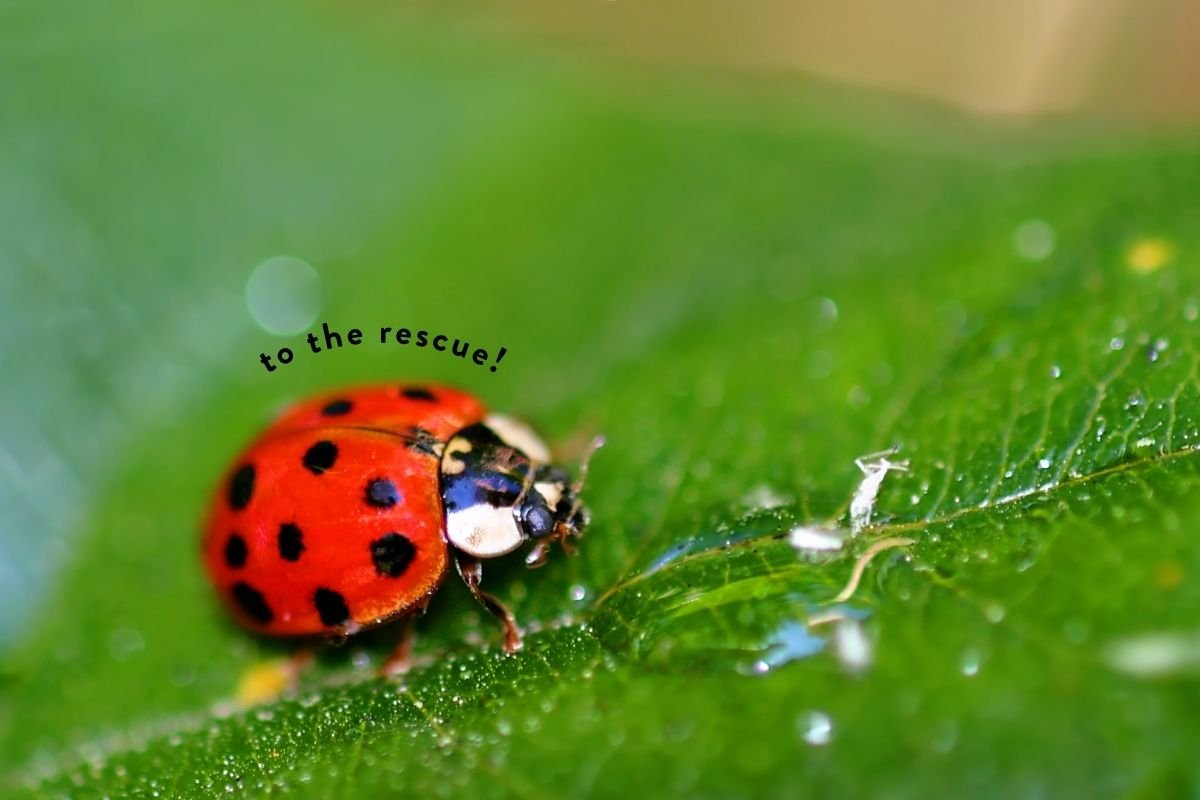
There are many natural, non-invasive ways of treating scale infestations on your monstera if you’re one of many people who like to keep their home chemical-free. Many horticultural oils, including neem oil, contain only natural, organic pesticides that are environmentally friendly, but always read the label to double check.
If you don’t want to jump straight into a pesticide, then you can do what we did and dip a cotton swab into some rubbing alcohol and “pick” the scale off the plant. Be sure to remove them from the pot completely, disposing of them away from plant life altogether. Wipe the area where they were living with the rubbing alcohol. Search for more signs of scale and wipe the areas with the alcohol-soaked cotton swab.
Another way to naturally eliminate scale insects on your monstera is to introduce natural predators that will kill off the unwanted pests. Parasitic wasps and ladybugs both eat scale bugs and won’t harm the plant in any way (though no promises about what wasps will do if set loose in your living room!). This method is probably best if your monstera is growing outdoors, or your climate allows you to move the plant outdoors while you treat it.
The bottom line
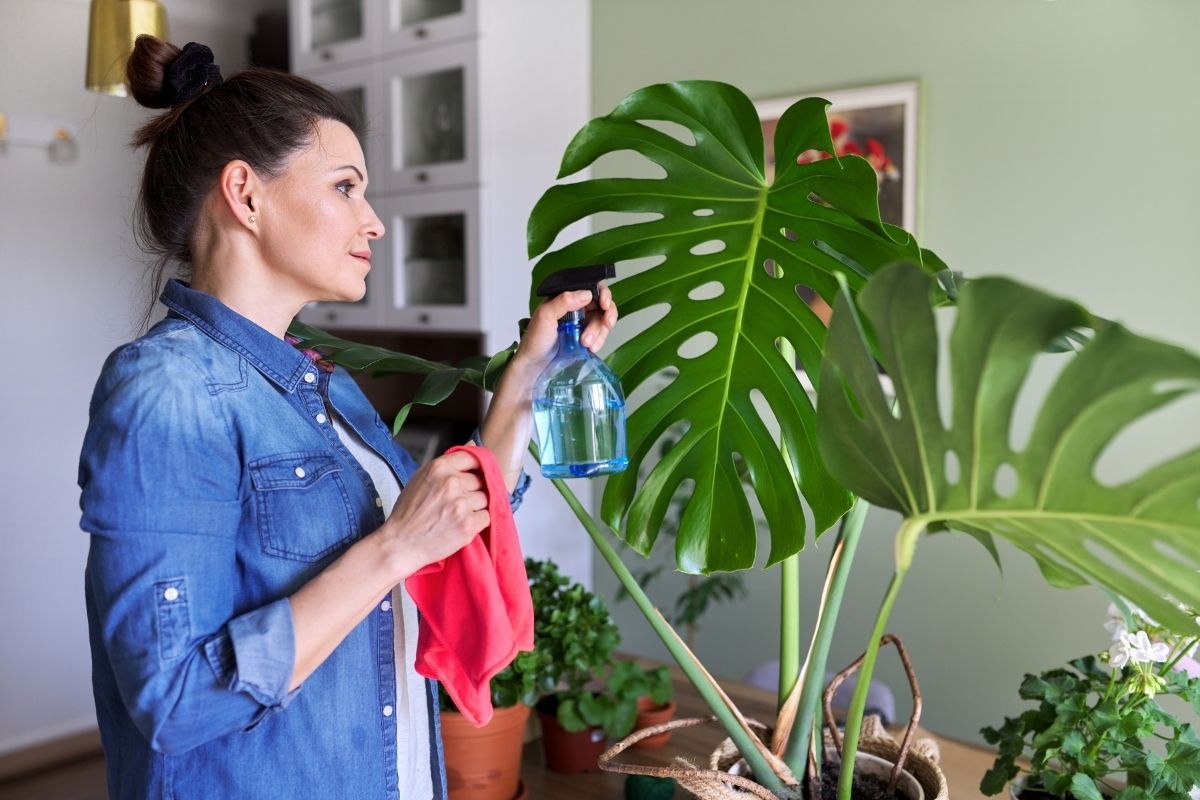
Scale insects can be tricky to deal with, especially if the infestation has had time to grow and spread. These predatory insects can affect almost any plant in your home or garden, including your beloved monstera. If you identify the pests early enough in their lifecycle, removing them can be as simple as wiping down affected leaves with a small amount of rubbing alcohol.
If the infestation has grown too large, you may need to use more intense remedies or even discard the whole plant in order to protect other plants in your space. Sigh. It can get that bad if you don’t take care of the infestation quickly.
Be proactive about the health of your plants and always keep them clean in order to avoid infestations of any kind, scale and otherwise. Giving your plants consistent attention is the best way to keep them healthy and pest-free.
More About Monsteras
- How Often To Water Monstera Plants
- Monstera Adansonii Care Guide
- Monstera Deliciosa Care: How To Care Of Monstera Plants
- Save Your Overwatered Monstera In 4 Steps (And How Not To Do It Again)
- Scale On Monstera: What To Do And How To Save It
- Best Soil For Monstera Plants (DIY Recipe + Store-Bought Options)
- Best fertilizer for Monstera plants for gorgeous leaves

